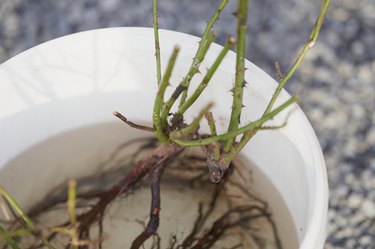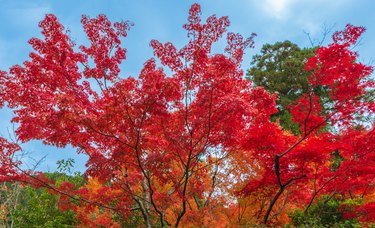
By September, you might feel like your garden is tired, and maybe you're tired too. But this is often the best time of year to gear up, get out your shovel, and plant.
Most shrubs and many trees are best planted in fall rather than spring, but not all plants are suited to make it through a long winter, so you need to be judicious when picking out that lovely plant at the nursery. Let's see what's good to plant in fall and which shrubs and trees would do better if you wait until spring.
Video of the Day
Video of the Day
Why Plant In Fall?
Many plants love fall for the same reason people do: They get a respite from the heat of a sometimes scorching summer — but it's more than just the air temperatures.
The soil temperatures are also still warm, there is usually some rain to provide important moisture, and the ground is not yet frozen. The days are shorter, which means the plants lose less moisture from the sun. In spring, the ground and soil may be frozen or too cold to promote root growth, and it could also be waterlogged.
Tip
If you live in a very northern clime and you have long, freezing winters, be very careful when planting in fall. Roots grow only when the soil is 40°F or warmer, and it takes about six weeks for newly planted shrubs or trees to establish their root system.
And let's remember that it's all about the roots. Fall is the perfect time for many plants to establish roots, which preps them to put on above-ground growth quickly in spring. But some plants, including most evergreens, will have a better opportunity for root growth if planted in spring. Let's break this down.
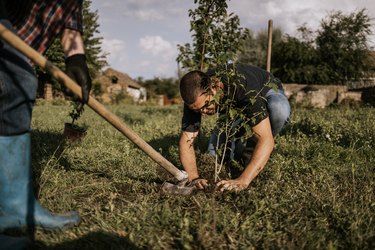
Plant These Shrubs and Trees In Fall
A general rule to follow is to plant deciduous trees in the fall and wait until spring to plant evergreens. To refine it further, plants with fibrous, shallow roots love getting a head start in the fall, but those that put down deep taproots can't recover quickly enough in the cold weather, so these are better planted in spring.

Choose only those trees and shrubs that are rated for your hardiness zone. For example, if you are in Eugene, Oregon like I am, choose plants that are rated for zone 8b, with an annual average winter low of 15°F to 20°F. This may seem obvious, but it's easy for a gardener to select a choice specimen at a nursery and then wait for it to leaf out in spring only to find that it has not made it through a 10-degree freeze.
Tip
Balled and burlapped trees and shrubs sold at nurseries in late summer and fall are designed to be planted as soon as they are purchased.
Choose Healthy Plants for Fall Planting
Nurseries and big-box stores frequently have fire sales at the end of the summer season. Some of these plants have been too stressed to be able to recover and establish roots in fall and winter.
Always choose healthy plants. Check the bottom of the pot to see if any roots have escaped the drainage holes; if so, the plant may be root-bound. In most cases, avoid these types of plants. If you really want to give a plant a try, tease out its roots after removing it from the pot using a spade or pruners.
Trees for Fall Planting
Apples and crabapples. Broadleaf deciduous trees are generally great for a home landscape. They range in size from dwarfs that might only reach 12 feet to full-size trees that reach 40 feet. They are grown in USDA zones 3 to 9. Note that these trees are also frequently planted in spring as bare roots. The genus Malus includes fruiting and ornamental types.
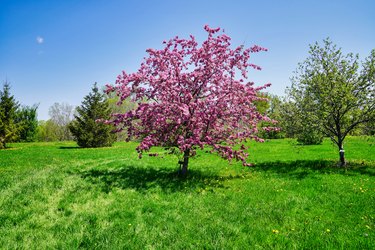
Elm. These are broadleaf deciduous graceful, large trees that grow up to 75 feet tall in USDA zones 3 to 9 depending on the species. The elm genus Ulmus contains multiple elm species, once ubiquitous across the country, but sadly, Dutch elm disease wiped out the American elm tree in most parts of North America.
Now, however, several disease-resistant cultivars of elm have been developed. These include Lacebark elm (Ulmus parvifolia); various newer cultivars of American elm (Ulmus Americana); and many hybrids, including Homestead, Cathedral, and Triumph.
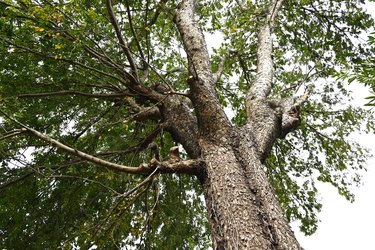
Linden. This is a broadleaf deciduous tree that has a pyramidal shape when young and then becomes more rounded. They can reach 60 to 80 feet tall and grow in USDA hardiness zones 3 to 7. The genus Tilia includes multiple species. One of the most popular is the littleleaf linden (Tilia cordata).
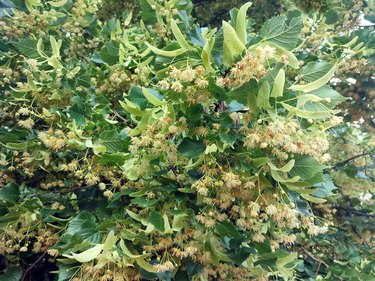
Maple. The ubiquitous maple tree (Acer spp.) is great to plant in fall. Because there are so many species, you can't pinpoint a hardiness zone or size, but most are quite cold-hardy. Of course, everyone knows and loves the Japanese maple (Acer palmatum).

Hawthorn. Hawthorns are so gorgeous, and the genus Crataegus includes more than 380 species! Be careful of the variety you choose, however, because they can wield some wicked thorns, hence their name. They generally range from about 25 to 35 feet in height with a USDA hardiness range of 3 to 8.
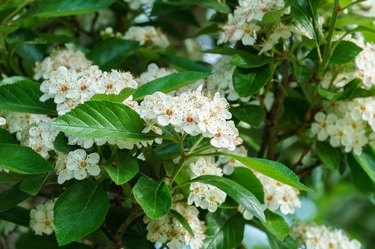
Japanese pagoda. This lovely flowering tree (Styphnolobium japonicum) can reach 50 to 75 feet in height in USDA hardiness zones 4 to 8. Its summer blooms are so numerous that they blanket the ground underneath it in white. But this tree does require some patience, as it may not flower for 10 full years, and its peak bloom may not appear until it is 30 years old.
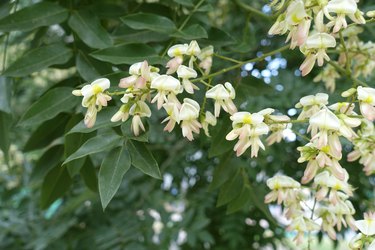
Some deciduous trees better recover from planting if you wait until they lose their leaves. Here are some examples.
Birch. Like maples, the deciduous trees and shrubs in the Betula genus number more than 60 species, of which common birch (Betula pendula) and paper birch (Betula papyrifera) are perhaps the most popular. Most species can reach 30 to 50 feet high and grow in a USDA hardiness range of 2 to 7.
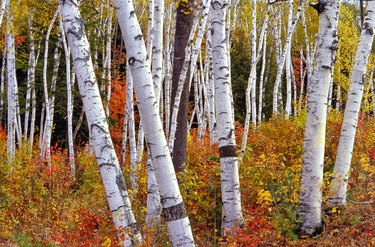
Dogwood. With its sumptuous bracts that appear like blooms, the dogwood is a must in every yard. The genus (Cornus spp.) comprises up to 60 different species growing in zones 5 to 8. The commonly available flowering dogwood (Cornus florida) grows from 15 to 25 feet tall, while the lovely Chinese dogwood (Cornus kousa) might reach 30 feet.
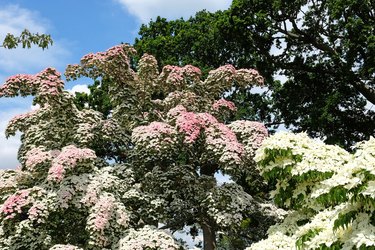
Sweetgum. A great shade tree, sweetgum (Liquidambar spp.) can reach 40 to 50 feet. This tree prefers acid soil (below 6.0), so be careful where you plant it. It grows in USDA hardiness zones 5 to 9.

Shrubs for Fall Planting
Fall is also a great time to plant most deciduous shrubs, such as lilac, viburnum, serviceberry, and forsythia.
Lilac. The unmistakable fragrance of lilac (Syringa vulgaris) can permeate a large area, so plant this stunner in a location where you'll be able to enjoy the fragrance as well as the showy purple spring flowers. It grows in USDA hardiness zones 3 to 7.
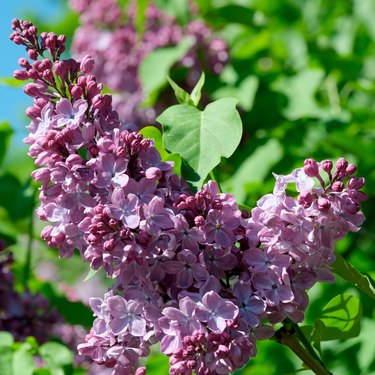
Viburnum. This genus includes a range of shrubs in all sizes, from the large wayfaringtree viburnum (Viburnum lantana), which might be considered a small tree at about 10 to 14 feet high, to the much smaller Korean spice viburnum (Viburnum carlesii 'Compactum'). Many species have those characteristic graceful, arching stems with creamy white flowers, such as doublefile viburnum (Viburnum plicatum). It generally grows in zones 4 to 7.
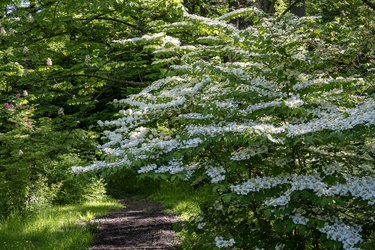
Serviceberry. This popular, spring-flowering multitrunked shrub can reach about 15 feet tall. Growing in zones 4 to 9, you may also find that this plant (Amelanchier spp.) is called sugarplum, shadbush, or juneberry.
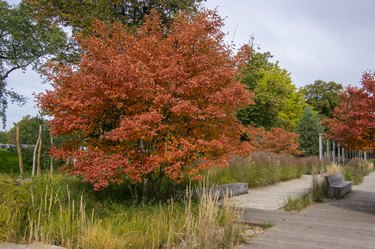
Forsythia. Cheery forsythia (Forsythia spp., zones 5 to 8) can brighten a dreary winter landscape with its lemon yellow blooms. This is a fast grower and can be brittle, so it may need staking, but its winter value is usually worth it. The species in this genus can reach 3 to 10 feet high.
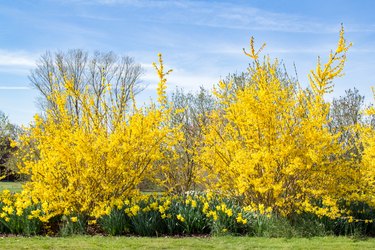
Tips for Fall Planting
Give your plants a boost as they prepare to hunker down for winter:
- Dig out weeds by the roots from the area around the hole.
- Dig a hole that's usually about the depth of the container and twice as wide. Check the plant tag for details.
- Add water to the hole before planting to make sure the plant starts out with a good amount of moisture.
- Place the tree in the hole so that the crown is at the same level it was in its pot.
- Backfill with the soil that came out of the hole (not purchased soil because you want the plant to acclimate to the native environment).
- Add about 10% to 20% compost to the hole for some oomph. You can omit this step if your soil is already well-draining and rich.
- Tamp down the soil to firmly establish the plant in the hole.
- Water well. During winter dry spells, continue to water so that your new plant never dries out.
Wait Until Spring for These Plants
If your plant is evergreen, it's almost never a good idea to plant in fall. Because evergreens hold on to their foliage throughout winter, they lose a lot of moisture through their leaves. This delays their ability to establish roots and also makes them more likely to succumb to winter injury.
For example, wait for spring to plant holly, arborvitae, magnolia, most oaks, and ginkgo. Also wait until spring for evergreen shrubs, such as azalea, rhododendron, and camellia.
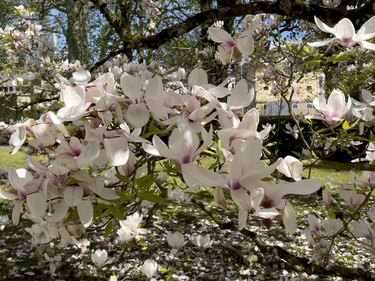
Never plant bare root shrubs or trees in fall. Fruit trees are frequently sold bare root, as are other trees and roses. It's very unlikely that you will find bare root plants in a nursery in fall, so this rule is easy to remember.
